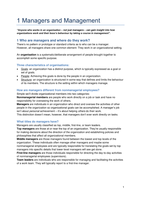Samenvatting
Summary Fundamentals of Management
Summary Fundamentals of Management: Essential concepts and applications (Robbins, DeCenzo & Coulter, 2014) Ninth edition. Useful summary of the most important chapters (including pictures of important schemes from the book). Chapters: 1, 3, 5, 6, 7, 8, 10, 11, 12, 14 & 15
[Meer zien]














